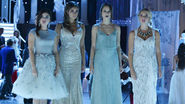-
About
- About Listly
- Community & Support
- Howto
- Chrome Extension
- Bookmarklet
- WordPress Plugin
- Listly Premium
- Privacy
- Terms
- DMCA Copyright
- © 2010-2025 Boomy Labs
 Kendra Brea Cooper
Kendra Brea Cooper
Listly by Kendra Brea Cooper
Anonymous text messages, video cameras, and laptop files are just some of the technologies that A and the girls use to their advantage. Anonymity in the digital age is easier and quicker, while past ways of solving identity mysteries through handwriting analysis and voice analysis are no longer relevant. Through this technology, identity is fragmented and re-created by the minute, and this makes it frustratingly difficult to find A (or any other technology stalker).
A is a pretty good representation of that fascist voice in the back of our minds reminding us that everyone is observing. It seems like A is always watching, and the girls constantly modify their behaviour even if they're not sure. We tend to watch each other and police each other, maybe not always directly through a text message, but indirectly through language, manners, narratives, and myths. Who is A? A is everyone around us.
Teenagers have never been easy to define, yet much of the television shows out there make an attempt to fit teen lives into a narrative that benefits a certain pattern in wider society. Teen stories are as controlled as teenagers, because as the next generation they hold great potential for resistance and social change. They are revolution in age. Teen lives are complex and always in the push and pull of resistance and complacency. The story line of Emily coming out to her friends and parents is a good example of how the writers show that complexity and social progress.
The bedrooms and the spaces the girls inhabit show us pieces of their identities. Television is different from literature in that the inner lives and values of the characters have to be told through the visual. The way these characters inhabit the space around them is key to figuring out who they really are inside.This is true to life because what surrounds us is often seen as part of who we are, and not separated from ourselves. If someone walked into your room, they would probably learn a lot from what you read, write, listen to, and wear. From Aria's colourful and eclectic bedroom, to Spencer's perfectly made bed, we can make out clues beyond language that help us understand them.
In Pretty Little Liars, all stories are one story. The era of the one genre storyline is over, and PLL is an example of this. Adolescent lives are hard to define and quickly changing, and so fitting teens into a box with hard lines is unrealistic for a smart drama/horror/suspense/romance/comedy like this television show. Not all stories can do this well, it's important to be able to weave in all of these tensions appropriately, and PLL does just that. Drama tends to bounce off both suspense and romance, while suspense and horror go hand in hand, and the comedy is placed perfectly. These genre relationships should be mixed and not separated as they naturally work together.
Pretty Little Liars is famous (in part) for the literature references in almost every episode. Famous books like Catcher in the Rye and Lolita hang in the background of our culture as the stories that change us, represent us, criticize us, and comfort us. One story alone cannot define us, but pieces of these stories make up the greater part of who we are as a culture. The writers of PLL know they they cannot tell this story, without all the other stories behind it.
Hitchcock films are famous for their turn of suspense, because they start almost as if they belong outside of the horror genre, and then by some twist, we're unexpectedly sitting in the middle of pure tension.The Hitchcock references in Pretty Little Liars come up from little hints like the Rear Window poster in the coffee shop to entire scenes mirroring Psycho and Vertigo. From Spencer and Toby seeing a row of birds on a power line in Ravenswood, to Hannah in a cast and wheelchair with nothing to do but wonder and watch, Pretty Little Liars does not fail the Hitchcock fan.
In some ways, Pretty Little Liars reminds us mystery lovers of the 90s cult classic Twin Peaks. The most obvious being the plot around the dead girl and finding her killer. Both stories involve quirky characters in a small town, trying to uncover a murder, while their own anxieties unravel in front of us. Every secret is revealed except the one they're looking for. They share dreams, blurry visions, best friends, and love triangles.



Pop culture and all that ideology sitting in the blind spot. Also crafts.